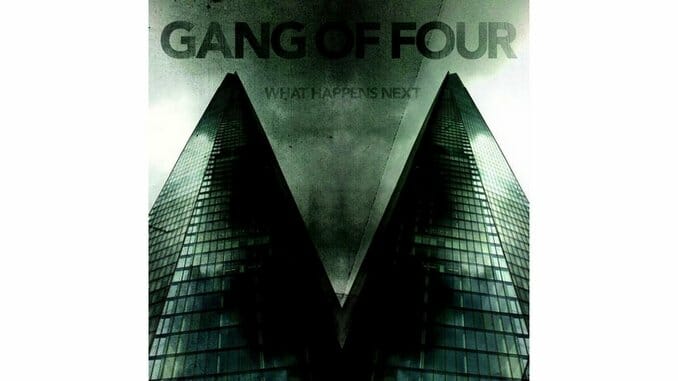
Edgy, intense and confrontational—Britain’s Gang of Four are one of those bands continually pushing against boundaries, musical and otherwise. Their first album, 1979’s Entertainment!, was hailed as a post-punk classic even at the time of its release, and you can hear the influence of Andy Gill’s scratchy guitar riffing in any number of alt-rock acts today (Kurt Cobain cited the album as one of his all-time favorites). The band’s commitment to their integrity was revealed early on when they walked off the set of UK music show Top of the Pops, after refusing to censor a line in “At Home He’s a Tourist” (and sing “rubbish” instead of “rubbers”), to their label, EMI’s displeasure. This was a band that consistently did things on their own terms.
But as the title of their new album so aptly puts it—what happens next? It’s a perfectly reasonable question. What Happens Next is the first Gang of Four album without co-founding vocalist (and primary lyricist) Jon King; guitarist Andy Gill remains the Gang’s sole original member. But as he recently explained to Chicago Innerview, Gang of Four have gone through more than one lineup change during their lifespan, and he viewed King’s departure as an opportunity “to reimagine Gang of Four from the ground up.”
What this means in the case of What Happens Next is that the band’s core lineup (Gill; John Sterry, lead vocals; Thomas McNeice, bass; Jonny Finegan, drums) has been embellished by a number of guest appearances; Japanese guitarist Tomoyasu Hotei provides the propulsive guitar riff that opens the album’s last song, “Dead Souls,” and Sterry shares vocal duties with Alison Mosshart (The Kills), former Gang of Four Member Gail Ann Dorsey (since known for her work with David Bowie), Germany’s Herbert Grönemeyer, and Robbie Furze (The Big Pink).
It’s an interesting experiment, as Sterry’s vocals aren’t that much different from King’s—raw and scraped, veering on the edge of agony. There are benefits to the additions; Dorsey’s cool harmonies give “First World Citizen” (a wish to clamber to the top of the consumer culture pile) a haunting touch, for example. Mosshart steps to the forefront on “Broken Talk” (the track most reminiscent of early Gang of Four, though with a bit more melody) and “England’s in My Bones” (with a great, taut guitar intro), drenching the latter in the kind of melancholy that readily brings to mind England’s gray, rain-swept streets.
Elsewhere, Grönemeyer brings a deep-voiced gravitas to “The Dying Rays,” and Furze adds a lighter, dreamy counterpoint to the short sharp rhythmic shock of “Graven Image.” But the band really shifts into high gear when Sterry is at the helm, which should bode well for the upcoming tour (which opens March 3 at the 9:30 Club in Washington, DC). This version of Gang of Four is clearly Gill’s vision, and if the group doesn’t sound as tightly wound as they did in their first incarnation, the angular guitar attack and the relentless pounding of the drums is a clear indication that the fire still burns within.